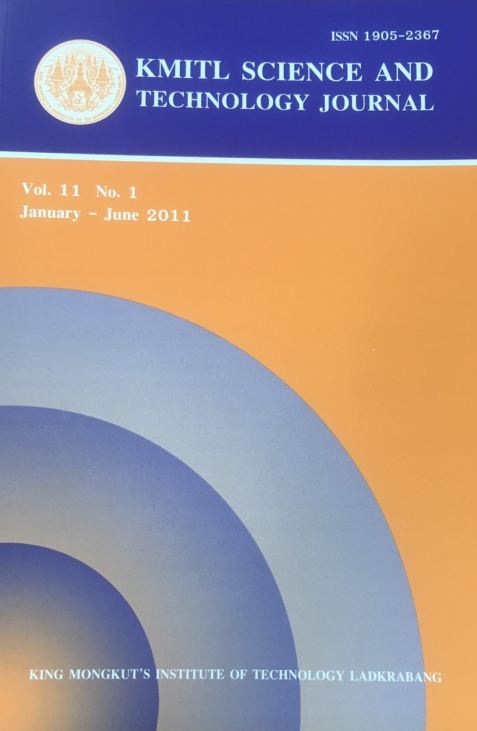Yield Potential, Heterosis and Ethanol Production in F1 Hybrids of Sweet Sorghum (Sorghum bicolor L. Moench)
Main Article Content
Abstract
Sweet sorghum is a potential raw material for food, feed, and fuel. The objective of this research was to study on agronomic yields and ethanol production in sweet sorghum F1 hybrids in Thailand. Twenty sweet sorghum F1 hybrids of crossed between 10 A-lines with 2 R-lines; KKU40 and Urja were tested in dry season during December 2009 to March 2010 at the National Corn and Sorghum Research Center with male parent lines and 8 checked varieties; Suphanburi 1, Cowley, Keller, Rio, Wray, Suwan Sweet #1, Suwan Sweet #2, and Suwan Sweet #3. RCBD with 3 replications was used. The result revealed that F1 hybrids had 39.75-56.04 tons ha-1 of stripped stalk yield, 32.27-52.93 percent cane juice extracted, 13.07-16.00 percent brix, and 0.88-2.21 kl ha-1 of ethanol yield. L103/KKU 40 gave the highest stripped stalk yield with high percentage of cane juice extracted and percent brix of 51.71 and 15.07%, respectively. L103/Urja gave the highest ethanol yield, percent brix, and grain yield. L104/Urja gave highest percent cane juice extracted but low percent brix, 13.80%. All F1 hybrids were early maturity and tall stature. The earliest F1 hybrids, 55 days to flowering were L101/Urja, L102/KKU40, L106/Urja and L107/KKU 40 and the tallest, 308 cm height were L103/KKU40 and L104/KKU40. Male parent lines KKU 40 and Urja had 48.33 and 48.53 tons ha-1 of stripped stalk yield, 39.24 and 37.83 percent cane juice extracted, 13.70 and 14.87 percent brix, and 1.28 and 1.37 kl ha-1 of ethanol yield. The means of checked varieties were 50.18 tons ha-1 of stripped stalk yield, 43.44 percent cane juice extracted, 14.93 percent brix, and 1.64 kl ha-1 ethanol yield. These F1 hybrids showed % heterosis over better male parent for days to flowering, plant height, percent brix, stripped stalk yield, grain yield, and percent cane juice extracted up to -7.83, 8.06, 7.60, 15.47, 66.33 and 34.89%, respectively. The high potential F1 hybrids were L103/KKU40, L103/Urja, L104/KKU40, L102/Urja, and L106/Urja.
Keywords: Sweet sorghum, F1 hybrid, agronomic yields, ethanol production
*Corresponding author: Tel: (66)89-580-3397 Fax: (66)44-361-108
E-mail: ijsthp@ku.ac.th
Article Details
Copyright Transfer Statement
The copyright of this article is transferred to Current Applied Science and Technology journal with effect if and when the article is accepted for publication. The copyright transfer covers the exclusive right to reproduce and distribute the article, including reprints, translations, photographic reproductions, electronic form (offline, online) or any other reproductions of similar nature.
The author warrants that this contribution is original and that he/she has full power to make this grant. The author signs for and accepts responsibility for releasing this material on behalf of any and all co-authors.
Here is the link for download: Copyright transfer form.pdf
References
[2] Doggett, H. 1988. Sorghum. 2nd ed. Tropical Agriculture Series. Harlow, UK; Longman.
[3] Corner, A. B. and Karper, R. E. 1927. Hybrid Vigor in Sorghum. Texas Agricultural Experiment Station Bulletim no. 359. College Station, Texas, USA; Texas A&M University.
[4] Stephens, J. C. and Holland, R. F. 1954. Cytoplasmic male-sterility for hybrid sorghum seed production. Agronomy J., 46, 20-23.
[5] Murty, D. S. Tabo, R. and Ajayi, O. 1994. Sorghum hybrid seed production and management. Information Bulletin no. 41, ICRISAT India.
[6] Ratnavathi, C. V. 2008. Alternative Uses of Sorghum Grain and Other Products. National Research Center for Sorghum, Hyderabad, India.
[7] Somani, R. B. and Taylor, J. R. N. 2003. Sorghum: A potential source of raw material for Agro-industries. CFC Technical Paper No. 34. ICRISAT.
[8] Rao, S. S. Seetharama, N. Dayakar Rao, B. Ratnavathi, C. V. and Reddy. C. S. 2008. Sweet sorghum: a potential energy crop for bio-fuel production in India. National Research Center for Sorghum, Hyderabad, India.
[9] Rao, S. S. Seetharama, N. Dayakar Rao, B. Ratnavathi, C. V. and Reddy. C. S. 1993. Descriptors for Sorghum [Sorghum bicolor (L.) Moench]: IBPGR and ICRISAT. International Crops Research Institute for the Semi-Arid Tropics (India).
[10] http//www.r-project.org/


